The Immense Pride and Unspeakable Agony of Gordon Hayward

This story appears in the Dec. 25, 2017, issue of SPORTS ILLUSTRATED. To subscribe, click here.
After the pain came the doubt, that nocturnal beast, always awakening as Gordon Hayward searched for sleep. He would lie in bed next to his wife, Robyn, head swirling with questions he couldn’t swat away: Will I be able to play again? Will I be able to jump again? What am I supposed to do now?
He could have scrolled through the million well-wishes on his timeline—literally, a million—but he is uncomfortable accepting attention for an injury. “I want it to be for a game-winner,” he laments. He could have read the dozens of self-help books he has received about overcoming adversity (Grit, by Angela Duckworth, is one he started), but the words don’t soothe him. “They just get me thinking more about my ankle.” He could have watched the Celtics—their latest triumph reairing on NBC Sports Boston—but then he’d stew until sunrise.
The only elixir sat on a desk in the third-floor den, glowing.
Hayward would slide out of bed, careful not to disturb Robyn, and pad down the hallway toward the light. The den, which overlooks his snow-covered front yard in the Boston suburbs, is furnished with a Costco-sized container of cashews, a football given to him by Peyton Manning and a basketball painted by Hayward’s twin sister, Heather, depicting the logos of his former teams. Guests pull up the number 20 stool he used in the locker room at Butler; Hayward sinks into a high-backed leather chair. He slips on a HyperX headset and faces twin monitors attached to a PC with his initials.
NBA players devour video games, but few master them like GTime, as he is known in cyberspace, studying strategies on YouTube and streams of professionals on Twitch.tv. Asking him to play Madden on Xbox is like inviting him to the Y for pickup. He graduated from casual gaming when his Halo team at Brownsburg High outside Indianapolis entered tournaments for cash prizes. He has earned a platinum rating in League of Legends, reserved for the top 5% of players in the world, and has convinced some fellow gamers that he could turn pro if not for the intrusions of basketball and family. For the past three years he has taken meetings about potential purchases into an eSports organization.
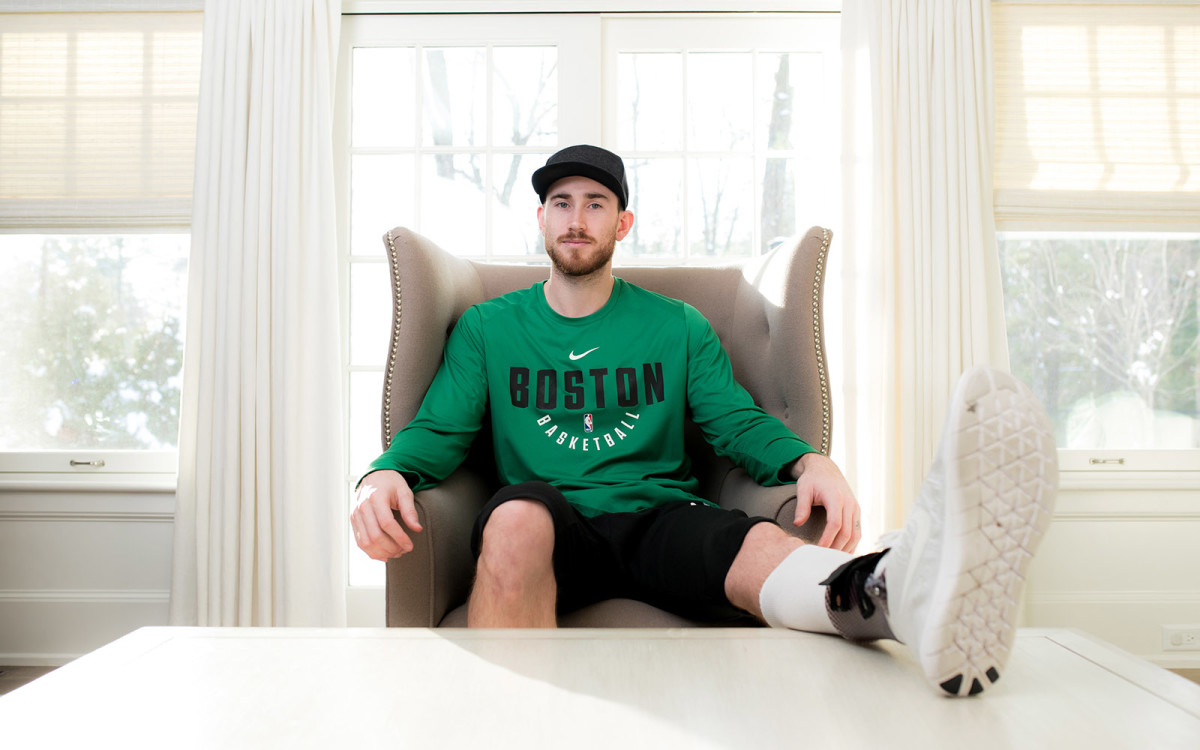
Since Hayward suffered a dislocated left ankle and a fractured fibula on opening night, five minutes and 11 seconds into his Celtics debut, he has been flanked by doctors, trainers, physical therapists and a sports psychologist. They are all trying to rehab his body and mind from one of the most gruesome and public injuries ever suffered on a court. But another element of his recovery unfolds alone in the darkness, where he opens the Discord app to check whether any members of his clan are online.
“If Gordon is there,” says Will Fahrenbach, “I’m hopping on with him.” Fahrenbach is a 28-year-old MRI technologist who lives in a two-bedroom condo in Salt Lake City. He met Hayward seven years ago through Halo, when GTime was a rookie for the Jazz, and later invited him to a New Year’s Eve party. They celebrated each other’s weddings and mourned a friend’s death. They shifted from Halo to StarCraft, Overwatch and the turn-based card game Hearthstone. But their pastime this winter, along with buddies in Utah and Indiana who compose their clan, is the futuristic first-person-shooter game Destiny 2. They need six players for a raid. Hayward relishes raids, the stiffest challenge the game offers: a test of vision, instinct and teamwork. They’re as close as he can get to a last-minute possession. Over the keyboard, he pours the competitive juice that normally spills on the court.
He clicks to exhaustion, trash-talking into the microphone on the headset, until his mind is still and his lids are heavy. Then he clambers back to bed and falls asleep next to Robyn, dreaming not of the playoffs or the Finals, but of a day when he can throw on that shamrocked jersey and play a game in three dimensions.
At 26–7, Boston has the best record in the Eastern Conference. Point guard Kyrie Irving is a top–five MVP candidate. Power forward Al Horford could be the Defensive Player of the Year. Rookie Jayson Tatum and second-year wing Jaylen Brown are revelations. But when president of basketball operations Danny Ainge watches the juggernaut he assembled, he can’t help but scan the arena for the missing piece. “What do we need?” Ainge wonders, the question that haunts general managers everywhere. “A versatile 6'8" defender who can switch one through four, handle the ball, create offense for others and make shots. That’s what we need. That’s Gordon Hayward.”
When the Celtics are on the road, Ainge sits next to Hayward in the weight room at the club’s headquarters in Waltham, distracting him from monotonous calf raises. “What do you think of the adjustment we made last night?” he asks, the day after a win in Detroit, atoning for a loss to the Pistons two weeks earlier. “Andre Drummond had 20 and 20 last time,” Hayward replies. “So we packed it in the paint, dared them to shoot, and they couldn’t throw it in the ocean. Maybe it caught them off guard.” When the Celtics are home, head coach Brad Stevens spells Ainge. Even though a flight from Chicago landed at 4:45 a.m., Stevens was at the facility by 11, ensuring he would overlap with Hayward.
Much was made of the bond between Hayward and Stevens during the free-agent signing period last summer, when the former Butler star rejoined the former Butler coach. Their college connection has been overstated, but they were always more than the typical power broker and lottery pick, using each other for five months and one tournament run. Stevens was the first recruiter to show up for Hayward’s 6 a.m. practices at Brownsburg, the first to offer him a scholarship, the first to tell him he might make the NBA when he still viewed himself as a Steve Nash wannabe. Initially, Hayward was dismissive, arguing with his father that Butler was in Division II. “If that’s my only choice,” he said, “I’d rather go to Purdue and just be a student.” But Stevens hung around, watching Hayward in showcases from three courts away so rivals wouldn’t notice whom he was tailing.
Stevens won him over, at least until Michigan called. Hayward wanted to drive to Ann Arbor for his official visit and Stevens generously sent directions—through Columbus, Cleveland and Toledo, detours that would have added about four hours. When Hayward returned from Michigan, he gushed about the facilities and the gear, but even the most direct route took too long. He was committing to Butler. A decade later, Stevens picked him up at Logan International Airport in Boston for his free-agent visit, and the 27-year-old forward felt a hint of homecoming. Hayward looked so different, his floppy hair styled, his slender physique chiseled. Stevens looked the same.
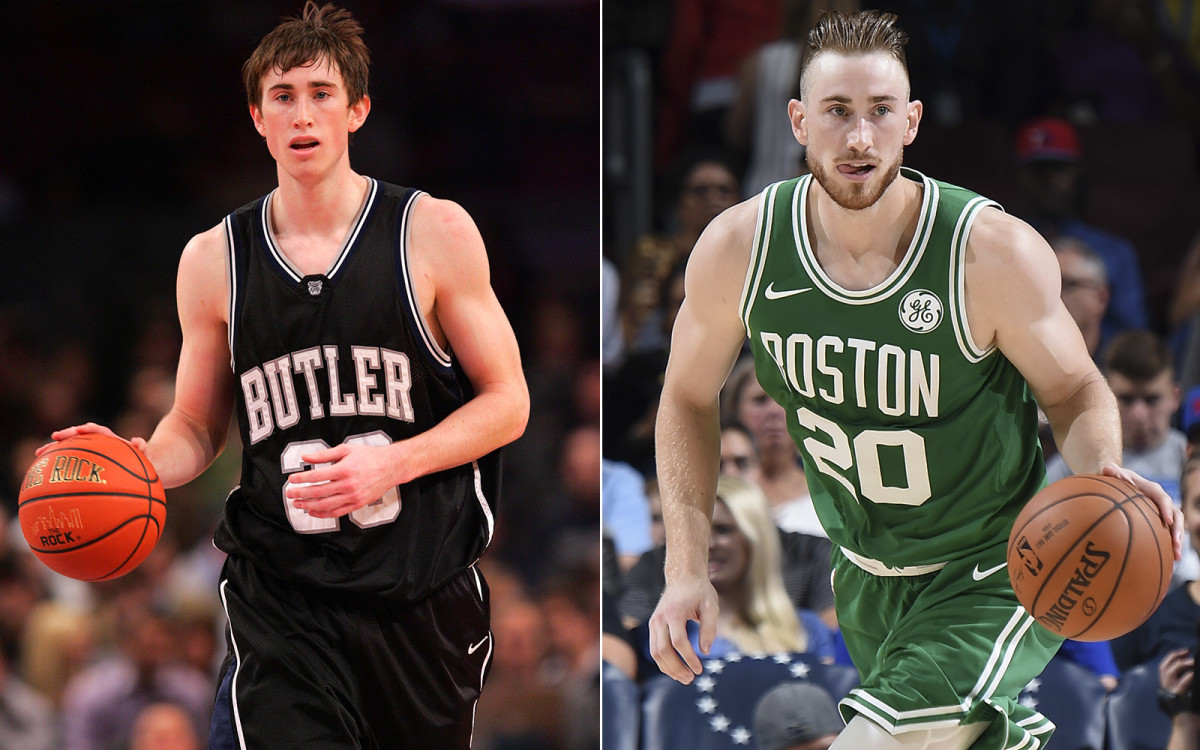
Ainge overhauled the roster, adding Hayward, Irving and Tatum, discarding Isaiah Thomas, Jae Crowder and Avery Bradley. Stevens and his staff were forced to reimagine the offense, with Hayward as a secondary ballhandler alongside Irving. Hayward and Irving could feed each other off pin-downs or weakside screens, and they could play a two-man game like Steph Curry and Klay Thompson in Golden State. “We did that a lot in training camp,” Hayward says. Horford was their Draymond Green, a third playmaker who could space the floor for Hayward and Irving or find them cutting. Normally, superstar clusters take more than a month to congeal, but Boston’s additions blended quickly. “The game was so easy, so natural,” Ainge says. “They fit so beautifully.” In the preseason finale at Charlotte, the Celtics polished their new pet actions, starting with Hayward and Horford at the elbows, or Hayward and Horford spaced on the weak side. They would lean on those sets in clutch situations.
Opening night was a spectacle, not because of Hayward but rather Irving, back in Cleveland for the first time since he asked out over the summer. Little can be gleaned from the first five minutes of a season, but Stevens was enthused. “We had a way about us,” he says. “You’re thinking, We have a chance to be pretty good.” With 6:52 left in the first quarter, and Irving cradling the ball on the left wing, Hayward cut behind Crowder on the weak side for a lob. It’s a play he ran all the time in Utah, and it always seemed to produce a dunk. But when the Celtics ran it in the preseason, it lacked the same rhythm, and Irving’s pass over Crowder came out low. At home in Chicago, Mark Bartelstein saw the tangle of bodies and turned away from the television. “I got this weird intuition,” says Bartelstein, Hayward’s agent, “like something bad was about to happen.” When he turned back to the screen, he felt a wave of nausea. He had to walk outside.
Stevens kneeled over Hayward in the key, the coach as shaken as the player, at the image of two feet pointed in opposite directions. The Celtics staggered to their bench and locked arms around assistant Micah Shrewsberry. “We have to lean on each other,” Shrewsberry implored. “Stay together.” Rookie forward Semi Ojeleye led a prayer. Boston was in a fog, falling behind by 18 points, and Hayward was in a panic, quizzing Bartelstein by phone from the locker room: “What does this mean? Is this the end?” As doctors scrambled, the Celtics rallied, cutting the final margin to three. “We lost, but I think that comeback helped lay a foundation with this group,” says Shrewsberry. “I think that started something.”
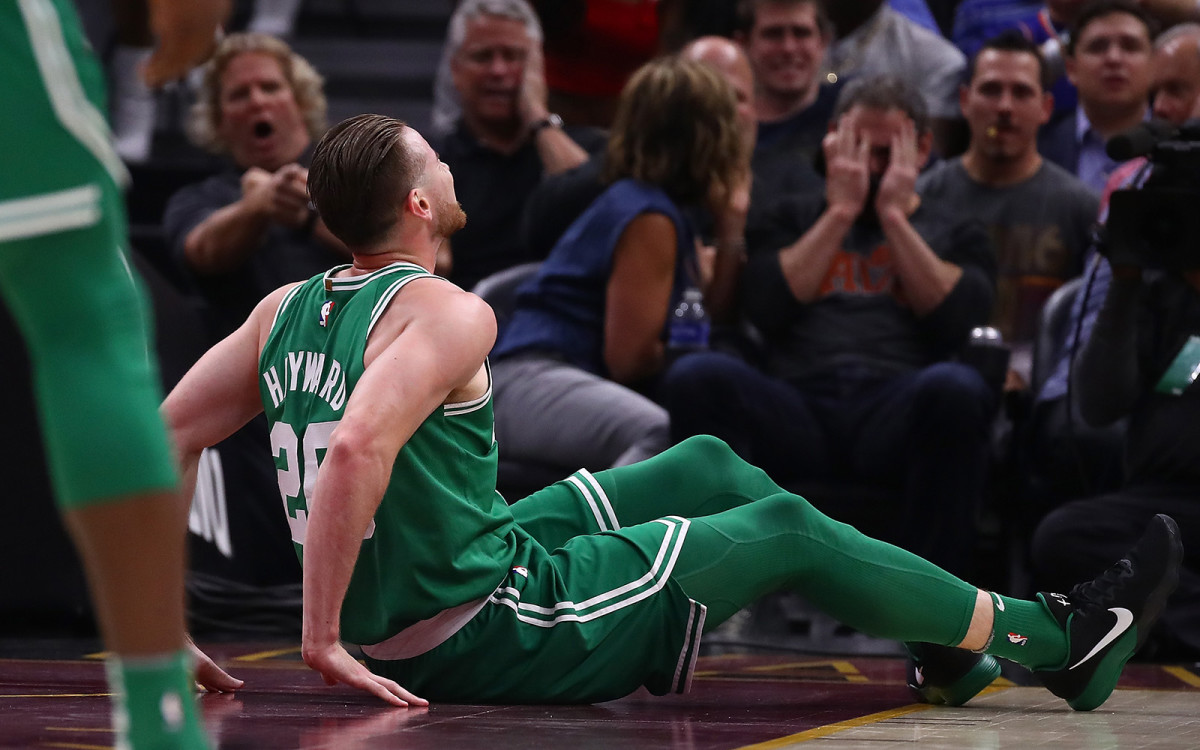
Boston lost again the following night to Milwaukee, but instead of the usual off-day after a back-to-back, Stevens called practice. He did not deliver an impassioned address. He simply relayed information. “Gordon’s going to be fine. Surgery went great. He’s in good spirits and now we have a job to do. We have 80 more games.” The Celtics knew they could coax more scoring from Irving and more playmaking from Horford. The wild cards were Tatum and Brown, No. 3 picks out of Duke and Cal, respectively, interchangeable two-way wings who can score without dominating the ball. Tatum seemed bright, grasping defensive concepts in summer league, and Brown resilient, grinding through rookie trials last season. During three-on-three drills in camp, Stevens would put five seconds on the shot clock, and they wouldn’t panic. “The age thing is not an excuse,” Stevens told them. “We’re not going there. You have to expedite it. You don’t get to fall asleep in a film session because you’re 19. No, you have to learn because we need you to be good.”
Tatum and Brown could not replicate Hayward’s ball-handling, so coaches installed more post actions for them. The next night, the Celtics won at Philadelphia, in front of a hysterical crowd. And then a strange thing happened to the contender that supposedly dropped from contention. They didn’t lose again for a month, coming back from 18 points down at Oklahoma City, 13 down in the fourth quarter at Dallas and 12 down in the fourth without Irving against Charlotte. “I think Gordon’s injury made us closer,” says guard Terry Rozier. They were a blast to behold, for everyone but the person who brought them together.
Early on, Hayward would hobble down to his basement theater at tip-off, fidgeting with the ball Stevens brought him in the hospital. “I could usually make it to halftime,” he says, “and then it would be like, All right, I’m done, I have to turn this off.” If the Celtics were winning, he felt sorry for himself, because he was missing out. If they were losing, he felt sorry for everybody else, because he couldn’t help. He tried going to a home game against the Warriors. “That was the worst,” Hayward says. “I was so close.” He retreated from the bench to the locker room for the second half as Boston toppled Golden State, a source of immense pride and unspeakable agony.
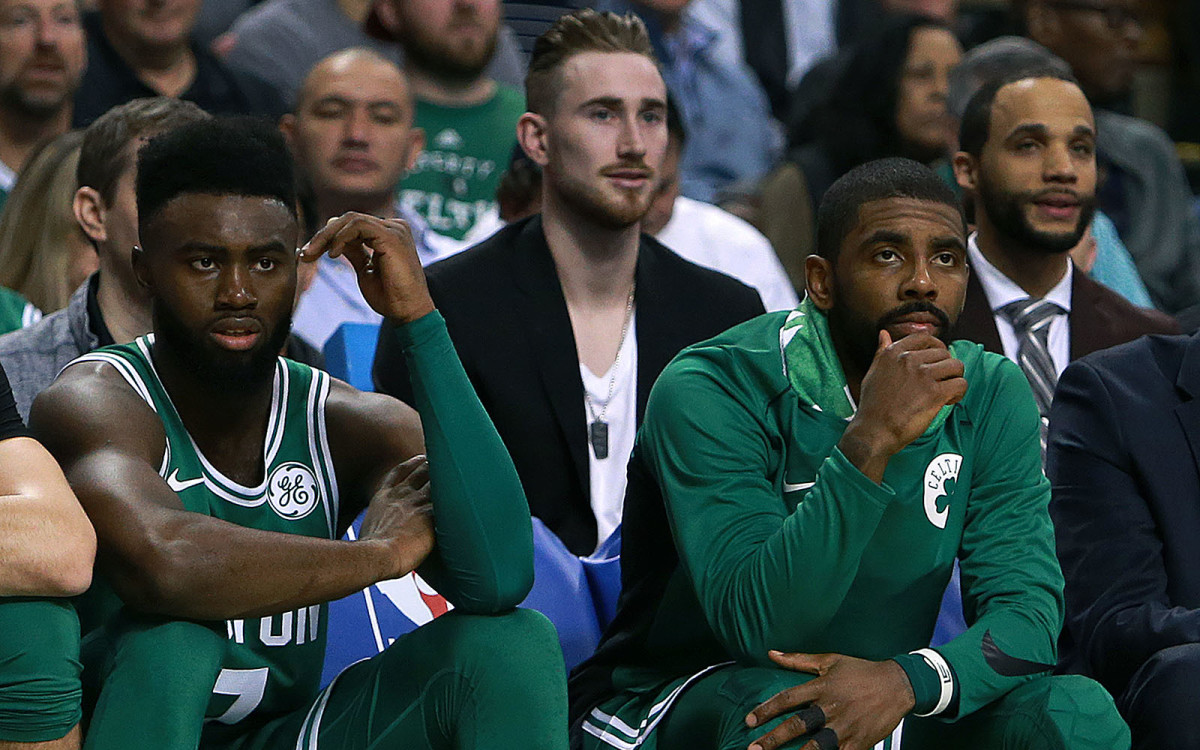
He settled into a rehab schedule, beginning at 7 a.m. to mirror his off-season workout routine. He was trying to deceive himself into believing it was still summer, with lifts at UC San Diego and breakfast at Claire’s on Cedros in Solana Beach. The first nor’easter of the winter shattered that fantasy. Jason Smeathers, Hayward’s personal trainer, who has known him since he was five, moved into the basement. Hayward craves distraction and Smeathers engages all his debates, whether the subject is the NFL slide rule or a compound math problem. “What do you get when you solve 48÷2(9+3)?” Hayward asks, scrawling it on a piece of paper. “It could be 288 or it could be 2, right, depending on how you read it.”
Gordon Hayward Sr. is an engineer who devised an algorithm to evaluate potential agents. His son started at Butler as a math and computer engineering double major. “He’s always been analytical,” Stevens laughs. “I would say overly analytical.” Hayward could not watch the Celtics as a cheerleader. He had to watch them as a scout. How are guys being guarded? What’s open? What’s not? What’s working? What’s not? Assistant Scott Morrison asked him about defending Kevin Durant. “Haha,” Hayward replied. “Good luck.” Stevens, alternating between big and small lineups depending on opponents, requested his input against Western foes.
Gradually, Hayward made it past halftime, extracting more joy from Celtics’ victories as he notched a few of his own. He shed the crutches and then the boot, hit the pool and then the bike. He shot from a chair and then discarded it, flipping underhand layups high off the backboard in his best Irving impersonation. Money keeps him engaged—$5 bets with Smeathers on around-the-world and Ainge on half-court chair shots, as do Eminem and Breaking Benjamin on the stereo. There are fans who have sent him get-well tweets every day since Oct. 17—“I can’t tell you how many from Cleveland,” he says—and friends who update a daily text thread. On his 31st day of healing they sent a picture of Reggie Miller, number 31. On the 41st day it was Dirk Nowitzki. On the 55th, White Chocolate, Jason Williams.
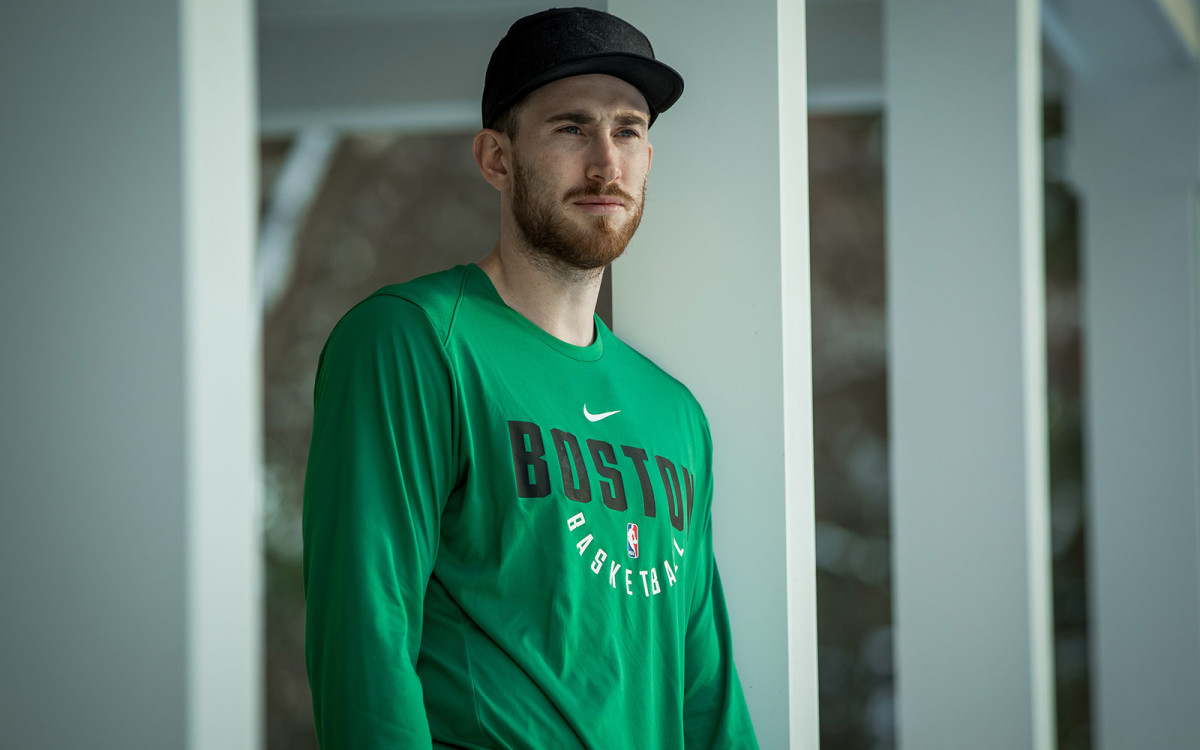
Hayward still won’t watch the 2010 Butler-Duke national championship game, lost when his half-court heave banked off the rim, but he calls up old highlights to remind himself what he can do. Morrison recently asked him to deconstruct video of his first three seasons in Utah with Celtics rookie Abdel Nader, a screening that benefited both of them. Ainge finds more solace in clips of the Indiana football team, specifically junior receiver Simmie Cobbs Jr., who broke his ankle in September 2016 and corralled 72 passes for 841 yards this fall. “He had the same surgery as Gordon, and eight to 12 months later, he was unbelievable,” Ainge says. “Cutting, jumping, looking like a first-round pick.”
No one expects Hayward to return this spring, but no one completely shuts the door. It’s cracked, because who knows how far Boston will advance and how fast Hayward will mend. In 2006, 76ers forward Shavlik Randolph was practicing four months after a broken ankle, though he wasn’t at full strength for about a year. “I was terrified when it happened that I wouldn’t be able to ever play again because it hurt and looked so bad,” Randolph texted from China, where he is with the Beikong Fly Dragons. “But it did not affect me long-term.... It will be just a matter of how long it takes to get his strength and mobility back. Different people get that back at different rates, but he is an elite athlete with a terrific work ethic, so I don’t see any reason why he doesn’t get all of it back relatively quickly.”
Hayward appreciates any optimism, but he is reluctant to entertain it, not when he is finally sleeping again. “Wishing to be on the court, trying to be on the court, those are the thoughts that kept me up at night,” he says. Cobbs and Randolph cannot relate to the attention focused on Hayward’s ankle, now protected by a small black brace. According to Google, the most-searched athlete in the United States in 2017 has been Floyd Mayweather. Second is Gordon Hayward. He does not venture out in public often, staying home with Robyn and their daughters, two-year-old Bernie and one-year-old Charlie. The family’s German shepherd, Siber, patrols a backyard ringed with pine trees. But Hayward visited two Boston children’s hospitals this month, and as he sat at bedsides and listened to stories, he felt the patients were doing more for him than he was for them. “Man,” he thought, “I’ve got it made. I just broke my ankle. That’s nothing.”
Hayward will step on the parquet again, whether in June or October, and the raid will be on. While Irving has forged an identity away from LeBron James, Tatum and Brown have seized opportunities spawned by Hayward’s absence. The Celtics’ war chest now includes headliners in their prime, prospects on the verge and, because of Ainge’s angling last June, another lofty draft pick to come. The present is gold. The future, as GTime might put it, is platinum.
